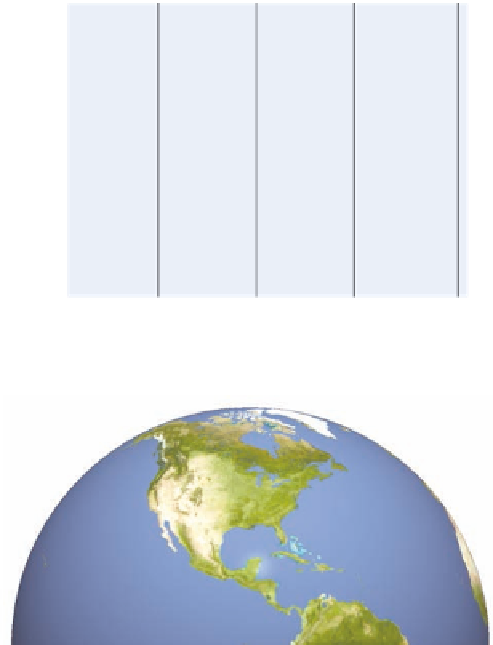Geoscience Reference
In-Depth Information
Spring
Equinox
Summer
Solstice
Fall
Equinox
Winter
Solstice
Spring
Equinox
Summer
Solstice
Fall
Equinox
Winter
Solstice
600
600
500
500
400
400
300
300
200
200
100
100
0
0
J
F
M
A
M
J
J
A
S
O
N
D
J
F
M
A
M
J
J
A
S
O
N
D
90° N
Spring
Equinox
Summer
Solstice
Fall
Equinox
Winter
Solstice
45° N
600
500
400
300
J
F
M
A
M
J
J
A
S
O
N
D
0°
Figure 4.27 Daily insolation through the year at the top of the atmosphere at select latitudes in the northern
Hemisphere.
Note that insolation changes at each of these locations on a seasonal basis and that the annual range
increases at progressively higher latitudes.
Human Interactions:
solar Energy Production
contain a number of mirrors, or
heliostats
, that indirectly gen-
erate electricity because they redirect sunlight into a fluid that
warms and produces steam. This steam, in turn, is used to pow-
er generators. These reflecting mirror systems are designed to
turn to follow the Sun over the course of the day so that they
constantly collect energy.
The use of solar power has distinct pros and cons. On the
one hand, solar power is a clean and sustainable energy source
that does not produce greenhouse emissions and thus does not
contribute to global climate change. Also, these systems can
produce electricity wherever the Sun shines. On the other hand,
the current technology is inefficient in producing an adequate
supply. Most photovoltaic modules, for example, convert only
about 10% of sunlight to electricity. Solar power plants are inef-
ficient, too, which is why they typically contain dozens (or even
hundreds) of collectors that funnel solar energy into a common
focal point.
Perhaps the biggest problem associated with capturing
solar energy is the simple fact that the Sun does not shine ev-
erywhere on a consistent basis (Figure 4.29). The Great Lakes
region of North America, for example, is cloudy much of the
time and is thus a poor place to produce solar energy on a large
scale. In contrast, the best place in the United States for solar
energy production is the desert region of the Southwest where
Humans have attempted to harness solar energy for practical
purposes for thousands of years. The Anasazi Indians of the
U.S. Southwest, for example, built their cliff dwellings on the
south-facing side of canyons so that the Sun would shine into
their homes and warm them during the winter. Since the oil
price shocks of the 1970s, and to lessen our reliance on fos-
sil fuels, more office buildings and homes today are designed
with windows that face the Sun when it is at a low angle during
the winter months (Figure 4.28). This angle allows the Sun to
shine directly into the building and enables heat to be trapped
by the glass. You can experience this kind of
passive solar heat-
ing
when you enter your car after you leave the windows rolled
up on a sunny day while you shop.
In addition to passive solar systems, efforts are under way
to further develop active solar systems that directly capture
solar energy and convert it to useful outputs. For example,
photovoltaic systems, or
solar cells
, change sunlight directly
into electricity; they tend to be used in remote places to power
devices such as lighted road signs that are not connected to
the electrical grid. On a much larger scale, solar power plants


























